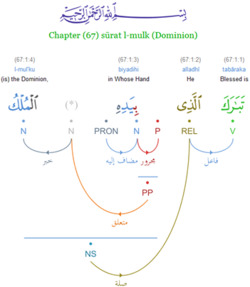- Dependency grammar
-
Dependency grammar (DG) is a class of syntactic theories developed by Lucien Tesnière. It is distinct from phrase structure grammars, as it lacks phrasal nodes. Structure is determined by the relation between a word (a head) and its dependents. Dependency grammars are not defined by a specific word order, and are thus well suited to languages with free word order, such as Czech and Turkish.
Algebraic syntax, Extensible Dependency Grammar, Tree-adjoining Grammar and Word grammar are types of dependency grammar. Link grammar is similar to dependency grammar, but link grammar does not include directionality in the relations between words, and thus does not describe head-dependent relationships.
Hybrid dependency/constituency grammar uses dependencies between words, but also includes dependencies between phrasal nodes. See for example, the Quranic Arabic Dependency Treebank.
Operator Grammar differs from other dependency grammars in that it is also a theory of semantics (information). This theory posits a large collection of reductions (small transformations) that map dependency structures into compact, variant forms. It also reverses the direction of dependency, by having operators (e.g. verbs) depend on their arguments.
Implementations
- Stanford parser A statistical phrase-structure parser which provides a tool to convert the output into a form of dependency graph called "Stanford Dependencies".
- DeSR A statistical dependency shift/reduce dependency parser.
- RelEx generates a dependency parse for the English language, by applying graph rewriting to the output of the link grammar parser. Open source license.
- XDG Development Kit An Integrated Development Environment for Extensible Dependency Grammar (XDG)
- TULE A linguistic framework that takes a natural language sentence in input (Italian) and returns a full dependency tree describing its syntactic structure.
External links
- Functional Dependency Grammar online demonstration
- Link Grammar online demonstration
- Extensible Dependency Grammar articles and grammar development kit
- Prague Dependency Treebank
- Quranic Arabic Dependency Treebank
- Word Grammar
- Depling 2011: The first International Conference on Dependency Linguistics

This syntax-related article is a stub. You can help Wikipedia by expanding it.

